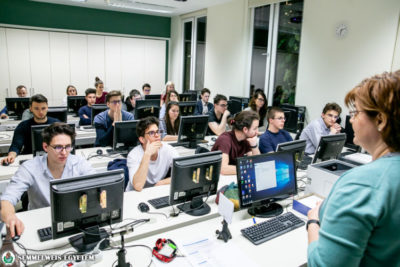Universities are diverse all around the world and so are the lists ranking them. In most cases, publication activity and citation are the main indicators and some rankings do not even take specialised universities into account. In our article the most well-known rankings are presented and the position of Semmelweis University in them.
The history of university rankings is over 150 years old. Carl Kořistka, professor of the Prague Polytechnic was among the first to make a compilation of the European polytechnic institutions in 1863. A few years later the U.S. Bureau of Education presented its own ranking, classifying the institutions in four categories. From the 1900s various writers, journals and institutions issued their own rankings including a professor of the University of Pennsylvania and the Chicago Tribune.
However, global rankings did not appear until the beginning of the 2000s. These were looking for the answer to the same question as the professor of the Prague Polytechnic did: which is the best university? Instead of inspecting the local or continental conditions, these rankings examine higher education globally. Universities and colleges are extremely diverse and so are the ranking lists: some put emphasis on research career, while others focus on the training of practitioners, some rank whole institutions, while others take only faculties or disciplines into account. Below, the most well-known and most cited global rankings are presented and Semmelweis University’s position according to each ranking.
 One of the first initiatives to rank higher education institutions globally is linked to Shanghai Jiao Tong University: the Academic Ranking of World Universities (ARWU) was launched in 2003 and today 1,800 universities are ranked based on six indicators. In their latest 2019 list only the first 1,000 universities are listed and the top 500 institutions are ranked according to disciplines. The indicators of the list mainly measure research activity (number of Nobel laureates, publications, citation), which is why larger universities stand a better chance of being included in the ARWU ranking. In the most recent list of 2019 Harvard University is at the top of the list and Semmelweis University is among the top 1,000 (901-1,000) despite the fact that smaller, specialised universities are at a disadvantage due to size-dependant indicators. In the ARWU Ranking of Academic Subjects 2019 Semmelweis University ranked 301-400 in the field of Clinical Medicine; 401-500 in the field of Public Health; 301-400 in the field of Medical Technology being the only Hungarian university in this list and 401-500 in the Pharmacy & Pharmaceutical Science.
One of the first initiatives to rank higher education institutions globally is linked to Shanghai Jiao Tong University: the Academic Ranking of World Universities (ARWU) was launched in 2003 and today 1,800 universities are ranked based on six indicators. In their latest 2019 list only the first 1,000 universities are listed and the top 500 institutions are ranked according to disciplines. The indicators of the list mainly measure research activity (number of Nobel laureates, publications, citation), which is why larger universities stand a better chance of being included in the ARWU ranking. In the most recent list of 2019 Harvard University is at the top of the list and Semmelweis University is among the top 1,000 (901-1,000) despite the fact that smaller, specialised universities are at a disadvantage due to size-dependant indicators. In the ARWU Ranking of Academic Subjects 2019 Semmelweis University ranked 301-400 in the field of Clinical Medicine; 401-500 in the field of Public Health; 301-400 in the field of Medical Technology being the only Hungarian university in this list and 401-500 in the Pharmacy & Pharmaceutical Science.
The lists generating the most media coverage are the Quacquarelly Symonds (QS) and the Times Higher Education (THE) rankings, which began their operation together in 2004 and evolved into separate rankings in 2009. THE is a London-based magazine which is a leading medium in higher education. Its ranking is audited by the PricewaterhouseCoopers; its methodology focuses on indicators of reputation based on publication and citation data and other factors (student-staff ratio, revenues, etc.). The latest THE ranking is led by Oxford University and Semmelweis University is the best Hungarian institution in the list with its 401-500 position. Times Higher Education also has lists for specialised universities featuring 11 disciplines: Semmelweis University is included in the Clinical, Pre-Clinical and Health list, as well as in the Life Sciences list ranking 301-400. In the first list, it is the best among the four Hungarian universities included in the ranking, while in the latter list, it is the second best Hungarian institution out of six.
 Due to their common roots, the methodology of QS is very similar to that of THE; the biggest difference is that QS considers the reputational questionnaire more important. QS is a multinational organisation, has offices in several countries around the world and its most cited world ranking does not include specialised universities, thus Semmelweis University cannot be a candidate for this list. Their most recently published ranking is led by the Massachusetts Institute of Technology (MIT). However, QS also produces rankings for specialised universities featuring 5 main and 48 narrower disciplines. Semmelweis University is ranked 295th in one main category (Life Sciences and Medicine), which is the best result among Hungarian universities. It ranked 151-200 in the narrower category of Pharmacy & Pharmacology and is among the top 250 universities in the field of Medicine.
Due to their common roots, the methodology of QS is very similar to that of THE; the biggest difference is that QS considers the reputational questionnaire more important. QS is a multinational organisation, has offices in several countries around the world and its most cited world ranking does not include specialised universities, thus Semmelweis University cannot be a candidate for this list. Their most recently published ranking is led by the Massachusetts Institute of Technology (MIT). However, QS also produces rankings for specialised universities featuring 5 main and 48 narrower disciplines. Semmelweis University is ranked 295th in one main category (Life Sciences and Medicine), which is the best result among Hungarian universities. It ranked 151-200 in the narrower category of Pharmacy & Pharmacology and is among the top 250 universities in the field of Medicine.
In addition to the three best-known rankings there are several other lists. Round Ranking, launched in 2013 operates with a methodology system similar to that of THE, but instead of reputation indicators, greater emphasis is put on student-staff ratio and revenues from education and research. In the list of Round Ranking Semmelweis University is 282nd and occupies prestigious places in three discipline lists out of six: 207th in Medical Sciences, 357th in Life Sciences and 205th in Social Sciences.
The US News and World Report ranks the universities of the United States and more than 60 other countries. Semmelweis University is included in the list of 1,500 universities ranking at 628, while it is the 112th best institution in the specialised list of Cardiac and Cardiovascular Systems. Semmelweis University is also among the top 300 universities in the categories of Clinical Medicine, Oncology and Neuroscience and Behavior and is listed among the top 350 in Molecular Biology and Genetics, and Biology & Biotechnology.
The Leiden ranking is based on bibliometric data: there are several parameters to select when looking at different ranking lists. Semmelweis University is at the forefront with respect to parameters taking international cooperation into account; it ranks 5th in the world when looking at the number of publications resulting from cooperation with industry partners.
Ádám Szabó
Photo: Attila Kovács – Semmelweis University
Translation: Ágnes Raubinek


